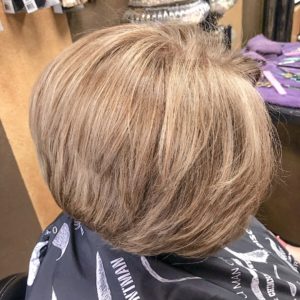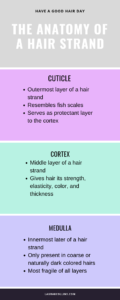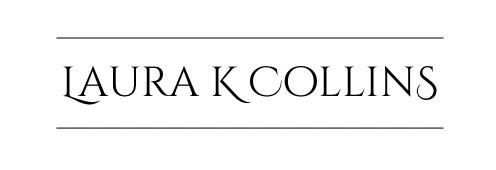Why Is The Anatomy Of Hair Important?
Have you ever brought in a picture of a haircut or style to your hair stylist, and when it’s recreated it just doesn’t lay the same? Why does it look so good on the model, but it doesn’t on you? It’s probably because you have a different hair type than the model in the picture.
There are certain hairstyles that work well on one hair type, and not so well on others. Granted, your stylist should inform you of this and make proper recommendations during the consultation. But unfortunately many stylists don’t do this and will just give you the look that you ask for.
It’s important to know what hair type you have so that you can pick hairstyles that will work best for you. This post explains the basic anatomy of your hair, the 3 main categories, and 3 sub-categories of hair types.

Hair anatomy 101
Before digging into hair type categories, let’s first begin by understanding the anatomy of a single strand of hair.
The 3 layers of a hair strand
Every strand of hair is made up of two to three layers. Naturally blonde and fine hair contain two of these layers, while coarse hair contains all three; but we’ll get to that in just a moment. The three layers of a hair strand are the cuticle, cortex, and the medulla.

Cuticle – Outer layer of a hair strand
The cuticle is the outermost layer of a hair strand and it resembles fish scales. These scales open and close just as the pores on your skin do when heated or cooled, as well as with water or steam.
Hair that is damaged has a roughed up and very open cuticle, while hair that is healthy has smooth scales that close and seal nicely. This is why damaged hair appears frizzy and also why it does not hold on to hair color as well.
If the outer scales don’t close properly, the color molecules are able to slip out much easier when shampooed, or even onto your pillowcase. This layer is the protective covering for the next layer, the cortex.
Cortex – Middle layer of a hair strand
The cortex is the middle layer of a hair strand. This is the layer that gives hair its strength, elasticity, color, and thickness.
When hair is colored (with permanent color), the color molecules need to get through the cuticle and penetrate to this layer. If the cortex is weak or damaged, then the elasticity will be poor and the hair will not stretch and return to its original state.
If you take a strand of wet hair and stretch it, it should feel strong and sturdy. When damaged hair is stretched it acts like bubble gum and typically just breaks off. The cortex becomes damaged when the cuticle is damaged and there is no longer that protective layer of scales covering it to keep it in good health.
If this layer is damaged the hair will also lose its wave pattern and go straight and limp. So if you have curly or wavy hair and the ends of your hair are straight and stringy, your hair is likely damaged and those straight ends need to be cut off.
Medulla – Inner layer of a hair strand
The medulla is the deepest, innermost layer of a hair strand. Not every hair type will contain this layer. It is seen in coarse and naturally dark hair strands. Naturally blonde and fine hair does not have this layer. The medulla is very small in diameter and is the most fragile of all three layers.
The purpose of this layer is still not completely known, considering not all hair even contains it. But hair that does contain this layer is typically much stronger and can take more abuse than hair that does not have a medulla due to the extra reinforcement.
That being said, hair with a medulla will also be more difficult to lighten and will take a higher temperature to curl or straighten.
The 3 Categories That Determine Hair Type
It is really easy to get confused about what hair type you have. A lot of people believe that if you have fine hair then you have thin hair and vice-versa, but that is not always the case.
All heads of hair are different and you can have any combination of the 3 categories. I have seen it all.
The three main categories that will determine your hair type are texture, density, and wave pattern.
I originally had all of this information crammed into one blog post, but I realized it was just TOO much. The post was over 6,000 words! So I divided each category into their own posts that you can access below.
On each post I describe the hair type and its strengths and weaknesses as well as give style and product recommendations that will work for you.
Hair texture
The texture of your hair is the thickness of each individual hair strand. It can be fine, medium, or coarse.
To learn more about what texture your hair is, visit my post here.
Hair density
Your hair density is the amount of hair that you have per square inch. This can be thin, medium, or thick.
To discover the density of your hair, see my post here.
Wave pattern
The wave pattern of your hair is the shape your hair takes in its natural state. It can be straight, wavy, or curly. Curly hair can also come in many shapes and sizes.
To read my post on wave pattern, click here.
Hair Type Conclusion
To conclude, understanding the anatomy of your hair is important for making informed decisions about hairstyles and hair care.
Every strand of hair is made up of three layers: the cuticle, cortex, and medulla, each playing a specific role in determining the health, strength, and appearance of your hair.
The cuticle is the protective outer layer (resembling fish scales), and its condition affects how well your hair holds onto color and resists damage.
The cortex (the middle layer) gives the hair its strength, elasticity, and thickness. Damage to the cortex can lead to weak, brittle hair that loses its natural wave pattern.
Lastly, the medulla (not found in thin and naturally blonde hair) offers extra reinforcement to the strand, making it stronger but also more resistant.
Recognizing your hair type is equally as important, as it falls into three main categories: texture, density, and wave pattern.
Hair texture refers to the thickness of each individual hair strand, which can be fine, medium, or coarse. Hair density relates to the amount of hair per square inch, varying from thin to thick. And the hair wave pattern is the natural shape your hair takes, like straight, wavy, or curly.
By learning about your hair type, you can choose hairstyles and hair care routines that will work for you instead of against you. Hairstyles that work well for one hair type may not be as manageable for another.
Next time you bring a picture to your stylist, make sure to ask if it will work well with your hair type instead of landing on something that may not be the best option for you.
If you have any further questions for me on this topic, leave them for me in the comments. And as always, Have A Good Hair Day!


